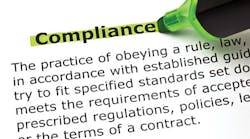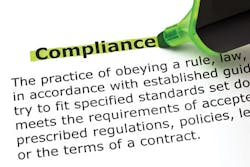By DIANNE GLASSCOE WATTERSON, RDH, BS, MBA
Dear Dianne,
I currently work for an office that is not adhering to several laws and regulations. Is there some way to convince the doctor to do the exam and be present at the office to complete the exam? Other problems include how to handle patients who refuse x-rays, relying on me to diagnose, and not having time to probe.
We have other problems that I don’t want to get into. I really don’t want to get fired for pushing the issue, but I also don’t want to lose my license for assisting in supervisory neglect, insurance fraud, and breaking OSHA regulations. I have checked the job market in my state (Connecticut), and there are no open positions. I can’t afford to quit and hope for something better to come along. What should I do?
Sincerely,
Anonymous
Dear Anonymous,
You’ve presented sufficient problems to fill several columns, so let’s try to break your situation down as succinctly as possible. Let’s start with exams. According to a document titled, “Dental Hygiene Practice Act Overview: Permitted Functions and Supervision Levels by State” on the ADHA website, Connecticut is a general supervision state, which means you can work even if the doctor is not on site. However, you cannot legally charge out an exam if the doctor doesn’t actually sit down and examine the patient. So just make sure you don’t charge out an exam if the doctor doesn’t actually perform one.
A few years ago, I consulted in a large Medicaid practice. The doctors were scheduled with patients in three operatories simultaneously. They did this because their no-show rate was high. However, the office was crazy busy, and there was no time for hygiene exams. So, the hygienists worked without doctor exams. Almost 100% of the children seen there had caries, so after seeing the hygienist for preventive care and radiographs, they were scheduled with a doctor for exam and restorative services. Most children were scheduled for the standard 40-minute doctor visit for their second visit. The exam was charged out when the children returned for restorative work because that’s when the doctors would perform the exams. It was a good solution for that practice.
As for radiographs, if the doctor allows patients to refuse them, just make sure the refusal is documented in the chart. Such refusals do not compromise your license. However, the doctor is increasing his or her liability risk by allowing refusal of necessary radiographs. You’ll notice I did not use the word “routine.” Radiographs should be taken when there is a need, not as a routine procedure. The ADA has a published guideline on radiographic frequency, and every dental professional should be familiar with those guidelines. (Google “dental radiography frequency guidelines” for the ADA document.)
Concerning diagnosis, hygienists have served in the role of “codiagnosis” for many years. In 99% of cases, hygienists identify dental needs and doctors confirm what the hygienists have found. That’s not “diagnosing”; that’s being part of the assessment process. Hygienists are certainly capable of identifying carious lesions and periodontal problems, and I believe most doctors appreciate their hygienists’ skills in those areas. When it comes to oral pathology, you’re taught to point out any areas of abnormality you may find, but you are not tasked with definitive identification of lesions or conditions. Make sure you are not confusing definitive diagnosing with assessment.
We learn ideal treatment and ideal infection control in school, but many offices are far from ideal. That reality does not excuse sloppy infection control. If your office is breaching OSHA rules, just make sure you are adhering to correct OSHA protocol yourself. I suggest that you take notes where you observe infection control being breached so that you have some written documentation. You might also mention to your doctor that OSHA has a training manual for dental offices that can be found at oshamanual.com/Dental/Manual. You could think about volunteering to be the OSHA liaison for your office.
As for insurance fraud, well, fraud is fraud. I really can’t help you there except to advise you to code correctly for what you do. You are not responsible for the acts of others in your office.
Periodontal charting and recording is a necessary part of high-quality care. When you know your patient will need periodontal charting on his or her next visit, allow yourself an extra 10 minutes for that task. If you schedule your patient’s next visit from the chair, you can allow for that. Be sure to mention to the patient that you will be performing a periodontal evaluation on his or her next visit. Also, any time you perform a charting, be sure to show it to the doctor when he or she comes in to do the exam. Point out any areas of concern.
You mentioned supervised neglect. According to Mosby’s Dental Dictionary, supervised neglect occurs when a patient is not informed of the presence or progress of a disease, although the patient is regularly examined and shows signs of a disease (Mosby’s Dental Dictionary: Edition 2, 2007). Either the disease is not being detected or the doctor chooses not to tell the patient. For example, say the patient comes in for regular preventive care, but no one is performing periodontal charting. (The standard is that every adult patient should have a periodontal evaluation once per year.) The patient has an 8 mm pocket at the distal of No. 29, but nobody has detected it. Allowing this disease process to continue without informing the patient is supervised neglect. Nobody has detected what should be glaringly evident because a key component of care has been neglected, i.e., periodontal charting.
In the past I’ve witnessed most, if not all, of what you’ve described in your question in one office or another. I was hired to do a job, just like my coworkers, and I was responsible for my job. So, if my coworkers were breaking rules, I had two choices - call it to their attention, or mind my own business. I never wanted to occupy the role of office police, so most of the time I just tried to do my job to the best of my ability, including keeping OSHA rules and adhering to ethical treatment planning for my patients.
It can be overwhelming and frustrating to work in an office with multiple problems. Everyone wants to work in an atmosphere where the correct protocol is followed, and where you don’t have to stress about things such as fraud and lack of proper standards.
However, just in case you didn’t know, there are no perfect offices out there. Most of us try to do the best we can, but even the best of efforts can fall short sometimes. When we see wrong being committed by others, we usually have to make a choice about whether we will become involved or whether we will let the chips fall where they may. I really believe we all reap what we sow sooner or later. You and I cannot make others do what is right, but we can, and should, make sure that we follow correct standards. If you can offer suggestions about how some processes can be improved, your suggestions are more likely to be well-received as opposed to if you just offer criticism.
All the best,
Diane
RDH
DIANNE GLASSCOE WATTERSON, RDH, BS, MBA, is an award-winning author, speaker, and consultant. She has published hundreds of articles, numerous textbook chapters, and two books. Dianne’s new DVD on instrument sharpening is now available on her website at wattersonspeaks.com under the “Products” tab. Visit her website for information about upcoming speaking engagements. Dianne may be contacted at (336) 472-3515 or by e-mail at [email protected].







